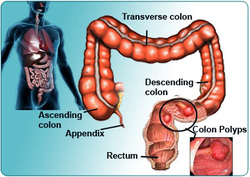|
|
Pathology definition - Polyps of the colon

Polyps of the colon
There are a few polyps on the colon. The polyps can be further divided into tubular adenoma, tubulovillous adenoma and villous adenoma.
The polyps are adenomatous in characteristic. The adenomatous commonly affecting individual age 50 and above. There is usually a strong family predisposition with mutation on the chromosome 5 which coded for tumor suppressor gene. However the intake of NSAIDS and aspirin may reduce the incidence of developing adenomatous polyps and colorectal adenocarcinoma.
Polyps of the colon may be asymptomatic in most cases. However, patient may present with rectal bleeding which finally lead to an iron deficiency anemia.
75% of adenomatous polyps of the colon are tubular adenoma. The tubular adenoma usually present as dysplastic epithelium with loss of orientation of the nuclei and hyperchromatic nuclei. Tubular adenoma mostly present as small and pedunculated stalk which is commonly found in the colon.
15% of adenomatous polyps are tubulovillous adenoma which is tubular adenoma with the surface covered by finger like projection/villi.
10% of adenomatous polyps are villous adenoma. Villus adenoma mostly present as broad based polyps/sessile polyps which are found in the rectum and sigmoid colon. Villous adenoma is characterized by finger like projection/villi which has a dysplastic columnar epithelium. Villous adenoma carries a high risk of developing colorectal adenocarcinoma.
The treatment may include removal of the polyps by surgical resection of the lesion which is done by using colonoscopy.
References
1.Allen, John I. “Molecular Biology of Colon Polyps and Colon Cancer.” Seminars in Surgical Oncology 11, no. 6 (1995): 399–405. doi:10.1002/ssu.2980110606.
2.Ekelund, Göran. “On Cancer and Polyps of Colon and Rectum.” Acta Pathologica Microbiologica Scandinavica 59, no. 2 (1963): 165–170. doi:10.1111/j.1699-0463.1963.tb01783.x.
There are a few polyps on the colon. The polyps can be further divided into tubular adenoma, tubulovillous adenoma and villous adenoma.
The polyps are adenomatous in characteristic. The adenomatous commonly affecting individual age 50 and above. There is usually a strong family predisposition with mutation on the chromosome 5 which coded for tumor suppressor gene. However the intake of NSAIDS and aspirin may reduce the incidence of developing adenomatous polyps and colorectal adenocarcinoma.
Polyps of the colon may be asymptomatic in most cases. However, patient may present with rectal bleeding which finally lead to an iron deficiency anemia.
75% of adenomatous polyps of the colon are tubular adenoma. The tubular adenoma usually present as dysplastic epithelium with loss of orientation of the nuclei and hyperchromatic nuclei. Tubular adenoma mostly present as small and pedunculated stalk which is commonly found in the colon.
15% of adenomatous polyps are tubulovillous adenoma which is tubular adenoma with the surface covered by finger like projection/villi.
10% of adenomatous polyps are villous adenoma. Villus adenoma mostly present as broad based polyps/sessile polyps which are found in the rectum and sigmoid colon. Villous adenoma is characterized by finger like projection/villi which has a dysplastic columnar epithelium. Villous adenoma carries a high risk of developing colorectal adenocarcinoma.
The treatment may include removal of the polyps by surgical resection of the lesion which is done by using colonoscopy.
References
1.Allen, John I. “Molecular Biology of Colon Polyps and Colon Cancer.” Seminars in Surgical Oncology 11, no. 6 (1995): 399–405. doi:10.1002/ssu.2980110606.
2.Ekelund, Göran. “On Cancer and Polyps of Colon and Rectum.” Acta Pathologica Microbiologica Scandinavica 59, no. 2 (1963): 165–170. doi:10.1111/j.1699-0463.1963.tb01783.x.
